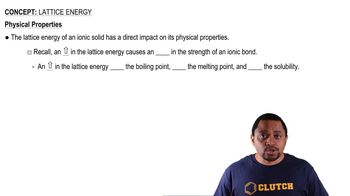Which statement correctly describes a difference between graphene and graphite? (a) Graphene is a molecule but graphite is not. (b) Graphene is a single sheet of carbon atoms and graphite contains many, and larger, sheets of carbon atoms. (c) Graphene is an insulator but graphite is a metal. (d) Graphite is pure carbon but graphene is not. (e) The carbons are sp2 hybridized in graphene but sp3 hybridized in graphite.
Ch.12 - Solids and Modern Materials
Chapter 12, Problem 103
Selected chlorides have the following melting points: NaCl (801 °C), MgCl2 (714 °C), PCl3 (-94 °C), SCl2 (-121 °C). (b) Predict which of the following compounds has a higher melting point: CaCl2 or SiCl4.
 Verified step by step guidance
Verified step by step guidance1
Identify the types of bonding present in CaCl2 and SiCl4. CaCl2 is an ionic compound, while SiCl4 is a covalent compound.
Recall that ionic compounds generally have higher melting points than covalent compounds due to the strong electrostatic forces between ions.
Consider the lattice energy of CaCl2, which is the energy required to separate one mole of an ionic solid into gaseous ions. This energy is typically high for ionic compounds, contributing to a higher melting point.
Examine the molecular structure of SiCl4, which is a covalent compound with discrete molecules held together by weaker van der Waals forces, leading to a lower melting point.
Based on the bonding and forces involved, predict that CaCl2, being ionic, will have a higher melting point than SiCl4, which is covalent.
Key Concepts
Here are the essential concepts you must grasp in order to answer the question correctly.
Ionic vs. Covalent Compounds
Ionic compounds, such as CaCl2, are formed from the electrostatic attraction between positively and negatively charged ions, resulting in strong ionic bonds. These compounds typically have high melting points due to the energy required to break these bonds. In contrast, covalent compounds like SiCl4 consist of molecules held together by weaker van der Waals forces, leading to lower melting points.
Recommended video:
Guided course

Ionic Compounds Naming
Lattice Energy
Lattice energy is the energy released when gaseous ions form an ionic solid. It is a key factor in determining the melting point of ionic compounds; higher lattice energy correlates with higher melting points. For CaCl2, the presence of divalent calcium ions increases the lattice energy compared to monovalent ions, contributing to a higher melting point.
Recommended video:
Guided course

Lattice Energy
Molecular Structure and Polarity
The molecular structure and polarity of a compound significantly influence its physical properties, including melting point. SiCl4 is a nonpolar molecule with a tetrahedral geometry, resulting in weaker intermolecular forces. In contrast, CaCl2's ionic nature leads to stronger interactions, thus affecting its melting point relative to covalent compounds.
Recommended video:
Guided course

Molecular Polarity
Related Practice
Textbook Question
Textbook Question
Selected chlorides have the following melting points: NaCl (801 °C), MgCl2 (714 °C), PCl3 (-94 °C), SCl2 (-121 °C) (a) For each compound, indicate what type its solid form is (molecular, metallic, ionic, or covalent-network).
Textbook Question
Imagine the primitive cubic lattice. Now imagine pushing on top of it, straight down. Next, stretch another face by pulling it to the right. All angles remain 90°. What kind of primitive lattice have you made?
